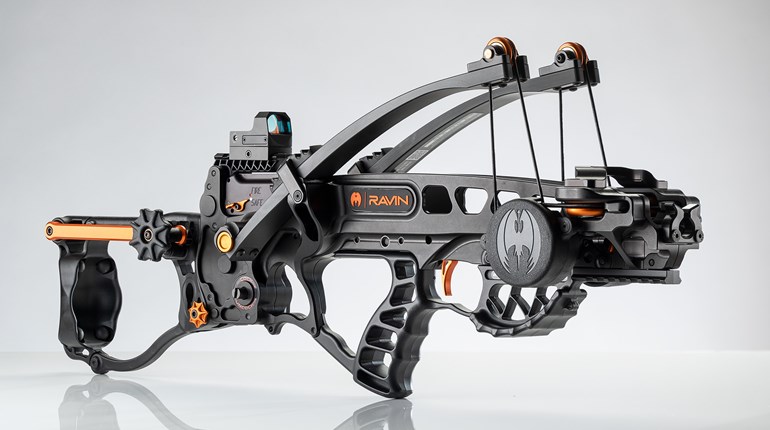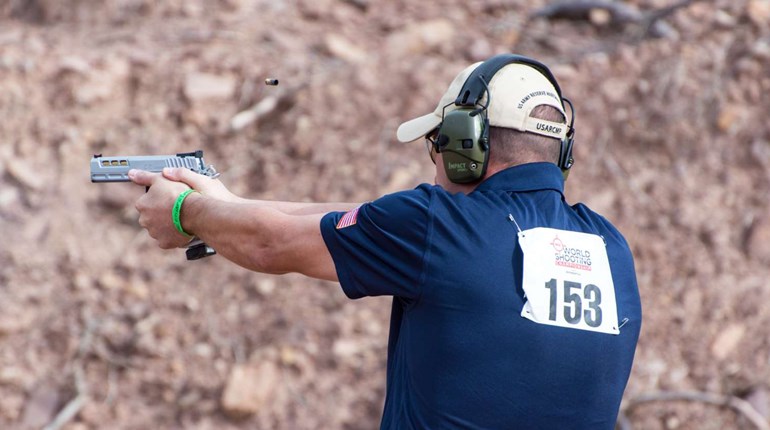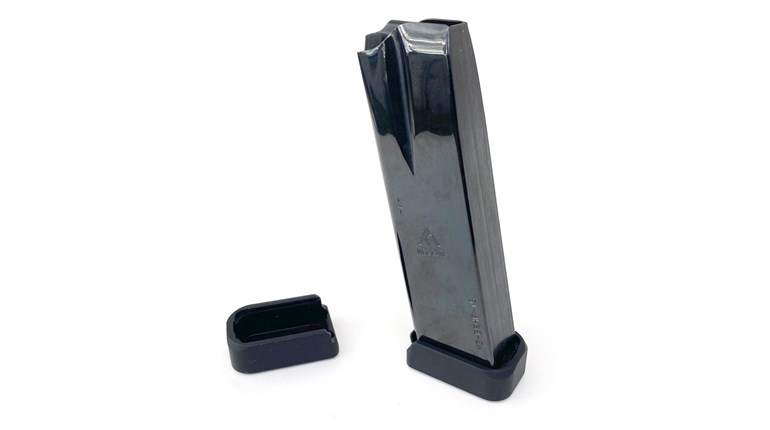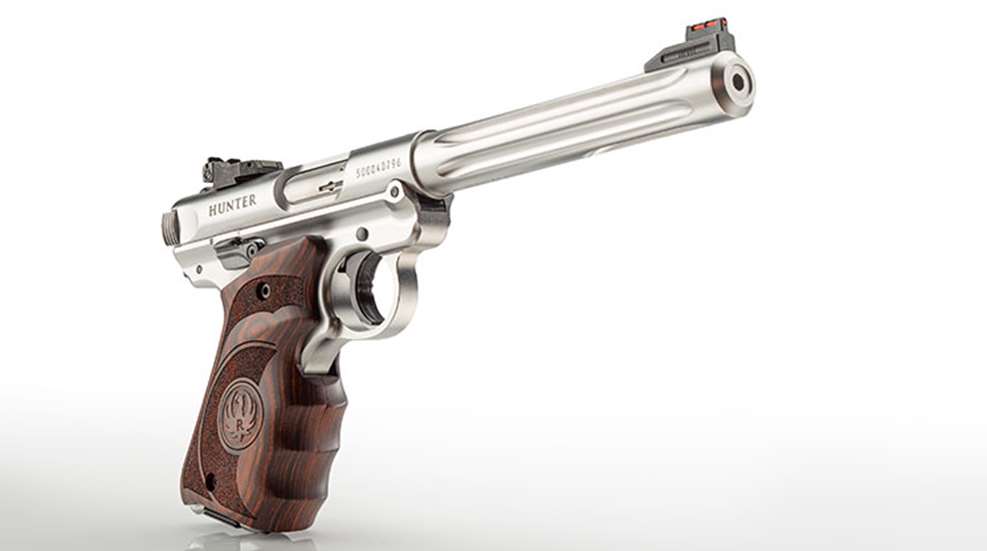
There’s an old saying that goes something like, “From a tiny seed a mighty oak tree grows.” A dedicated handgunner of several decades like me might alter that slogan to read, “From a small .22-caliber pistol a mighty firearm manufacturer grew.” Yes, I’m talking about Ruger, and I’ve watched the entire process in my lifetime. As a kid, I saw pictures of the Ruger Standard and thought it was cool that someone could capture the spirit of the Luger pistol and build it into a .22 handgun that nearly everyone could afford to buy and shoot. Now, 68 years later, a variation of that gun is still a major component in the success of the Ruger empire.
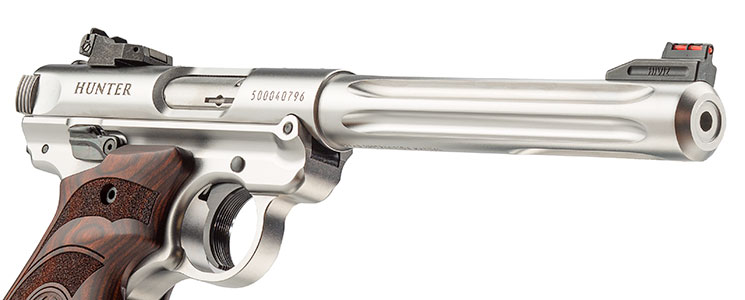
The family resemblance is rather faint between the original Standard and the new Mark IV Hunter. Except for a few components, the Hunter is all stainless steel with a handsome, brushed satin finish (the Standard was blued carbon steel). The Hunter’s bull barrel is almost 7 inches long and has six flutes (the Standard had a 4.75-inch tapered barrel). Plus, the Hunter sports the most attractive set of factory grips I’ve ever seen on a Ruger. They’re made of laminated wood with finger grooves that wrap around the front in a classic target configuration. Areas of texture that resemble stippling surround a large Ruger logo on each side. Overall, it’s a very striking handgun.
The iron sights on the Mark IV Hunter are two of the non-stainless components I mentioned above. The front sight is a red fiber-optic element mounted in a conventional base that’s screwed into the barrel. The rear sight looks like Ruger’s standard adjustable rig but has a V-notch blade with a white vertical line at the base of the notch.
While I acknowledge the advantages of such sights, I have difficulty controlling elevation with them. That’s not a huge drawback in this case for two reasons. First, I can replace the front and rear sights with more conventional hardware. Second, I immediately mounted a Burris 2X pistol scope, knowing I would need an optic to fully take advantage of the Hunter’s capabilities. The drilled and tapped receiver makes it easy to install a one-piece Weaver base or Picatinny rail, both available from Ruger. For the sake of expediency I used a blued rail and rather large rings with extended tightening levers. While the setup worked fine for accuracy testing, the Hunter’s aesthetics demand a more attractive, streamlined mount.
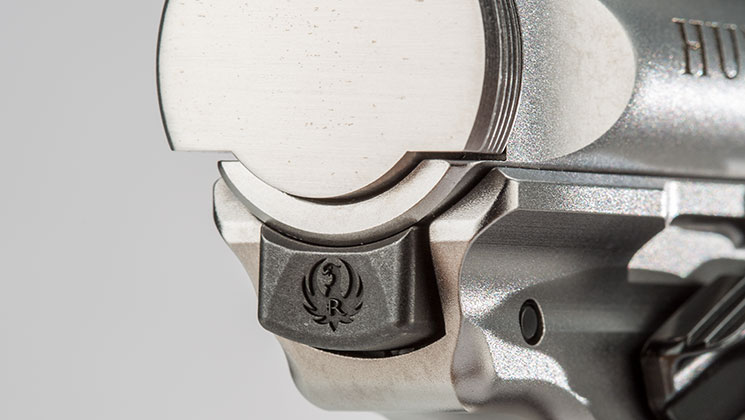
Operating controls on the Hunter seemed easier to work than on older Ruger Mark series pistols. I had to shift my shooting hand to press the magazine release button, but I could work the slide release and safety levers with no change in my grip. As a right-handed shooter, I wouldn’t spend extra money for an ambidextrous safety on a .22 pistol, but the Hunter came with one installed as a standard feature. I could easily operate it with my left hand, and normally I can’t easily do anything left-handed. The safety lever on the right side of the frame is not difficult to remove and replace with a washer should you prefer a cleaner look.
Another major difference between earlier pistols and the Mark IV Hunter is the ease of disassembly. It’s literally as simple as pushing a button at the rear of the frame and tilting off the barrel/receiver assembly. No special tools or extra hands required. If I can find the engineer responsible for the design, lunch will be on me.
I used what .22 LR ammo I had on hand for accuracy testing, and the results speak for themselves. Of the four loads I tried, three of them kept five-shot groups inside an inch at 25 yards. And that’s from a shaky old gunwriter who drinks coffee and smokes cigars! The Hunter had no malfunctions with three of the loads; however, it experienced two feeding problems with CCI Velocitors.
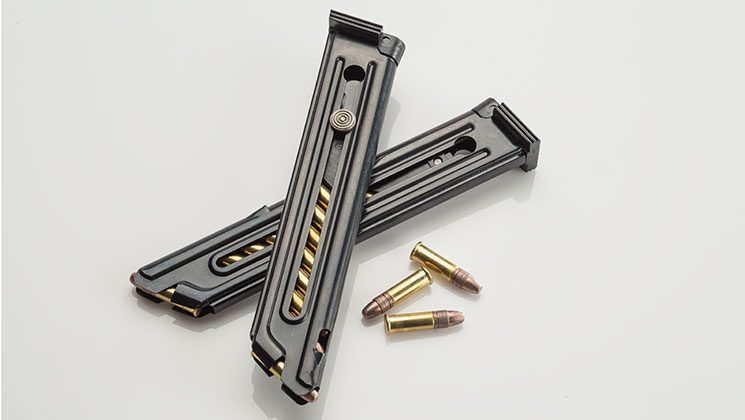
Accuracy aside, my shooting sessions revealed a couple of minor faults. The grips were slightly too large for my hands. As beautiful as I think they are, I’d probably replace them if I were going on a hunt. The second issue was the trigger; it was a bit too heavy and had a slightly gritty feel. Perhaps this was aggravated or exaggerated because of the large target grips and my stubby fingers, but I’d definitely get some work done on the trigger.
I don’t consider either comment a serious criticism. Grip size is strictly a personal-fit problem all shooters must address. The trigger pull is more the result of our litigious society than an indication of a manufacturing problem. My only real criticism is Ruger released the new pistol at a time when it’s difficult for me to get away on a varmint hunt. Fortunately I have a plan for summer, and it includes the Mark IV Hunter.
Technical Specifications
• Type: semi-automatic pistol
• Caliber: .22 LR
• Magazine Capacity: 10 rnds.
• Barrel: 6.88″; stainless steel; 1:16″ RH twist
• Trigger Pull Weight: 4.75 lbs.
• Sights: adjustable rear, fiber-optic front; drilled and tapped for optics
• Safety: ambidextrous frame-mounted lever
• Grips: target-style laminate
• Metal Finish: satin stainless
• Overall Length: 11.12″
• Weight: 44 ozs.
• Accessories: spare magazine
• MSRP: $799; ruger.com













